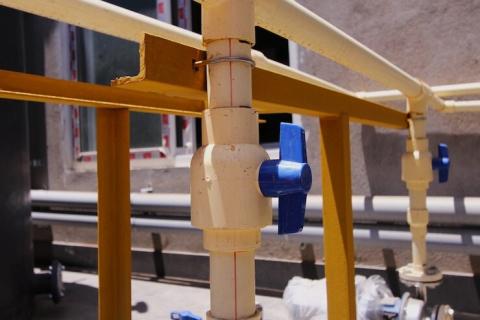
Homeowners and plumbers alike often use plastic pipes instead of metal pipes for plumbing projects because plastic pipes are inexpensive, lightweight, and will never corrode. They’re good at keeping hot water hot, and they don’t collect condensation from cold water like metal pipes do.
ABS and PVC pipes, the two most common plastic pipe materials, have some key differences. Whether you use one or the other depends on your local building codes, the nature of your project, and your personal preferences. Some local governments mandate the use of one pipe over the other, so be sure to check your building codes before you start your project.
What is ABS pipe?
ABS, or acrylonitrile butadiene styrene, is a black plastic pipe that is commonly used for drainage, sewage, and vents. It is also often used in drain-waste-vent (DWV) systems to remove wastewater.
ABS is ideal for these applications because it’s very durable and can withstand low and high temperatures, making it resistant to both chemical and physical damage. It won’t corrode or rust like metal pipes. Because it’s resistant to a variety of chemicals, it’s well-suited for use in industrial settings, like factories or laboratories.
A more significant difference between ABS and PVC pipes is that ABS contains BPA or bisphenol A. BPA is a plastic hardening agent that extends the life of the pipe but can leach into the water that flows through it. Although there are concerns about the potential negative health effects of BPA, the Food and Drug Administration has determined that BPA is safe at the current levels occurring in foods.
What is PVC pipe?
PVC, or polyvinyl chloride, is a white or light-colored plastic pipe that is most commonly used for plumbing and drainage. Like ABS, it is also often used in drain-waste-vent or sewerage systems to remove waste.
PVC is also durable, resistant to chemical and physical damage, and does not corrode. It is more flexible than ABS, making it less likely to crack or break under pressure. The flexibility and softer material of PVC also allow it to withstand hotter temperatures without deforming.

ABS vs. PVC
Besides the differences in the uses and physical qualities of ABS and PVC, there are also differences in the cost of the pipes and the cost of installing them.
ABS pipes have a one-step connecting process—they can be bonded instantly with special cement. PVC pipes have a two-step connecting process, where the pipe ends must first be treated with a purple primer before the cement can be applied. The primer must dry fully before the next step, so it can add extra labor to a project. For this reason, ABS can sometimes be the most cost-effective choice even though ABS pipes are slightly more expensive than PVC pipes.
Here is a summary of the main differences between ABS and PVC pipes:
ABS
- Black
- Used for drainage, sewage, and vents
- Contains BPA
- Handles lower temperatures well
- Less flexible but stronger and more shock-resistant
- Can warp with exposure to direct sunlight
- One-step pipe connecting process
- May be more cost-effective
PVC
- White or light-colored
- Used for drainage, sewage, and vents
- Does not contain BPA
- Handles higher temperatures well
- More flexible and less brittle
- Better at handling direct sunlight
- Two-step pipe connecting process
- Better at muffling the sound of running water
- May have higher labor costs
FAQs
ABS vs. PVC in sunlight: which is better?
ABS can handle both high and low temperatures, but compared to PVC, it does not respond as well to direct sunlight. Some plumbers paint ABS pipes with a UV-resistant chemical to make them less likely to warp.
ABS vs. PVC for drain pipes: which is better?
ABS pipes are better suited for outdoor underground plumbing because of their strength and resistance to shock, so they’re usually the go-to choice for sewage drains. PVC can also be used outdoors, but it is commonly used indoors for plumbing and water supply systems.
What are the types of ABS pipes?
ABS pipes are sold in 10’ and 20’ lengths. They’re available in solid-wall and cellular-core construction in Schedule 40 dimensions. These two forms can be used interchangeably for drain-waste-vent applications. The pipe wall of a Schedule 40 ABS DWV pipe is the same thickness as Schedule 40 (IPS) steel pipe.
Contact Stephens Plumbing
If you are planning a plumbing project for your home or business, or you are still unsure of which pipe to use, contact the plumbing installation and repair specialists at Stephens Plumbing. Our licensed technicians are ready to help you complete your project or provide emergency plumbing services if necessary.

